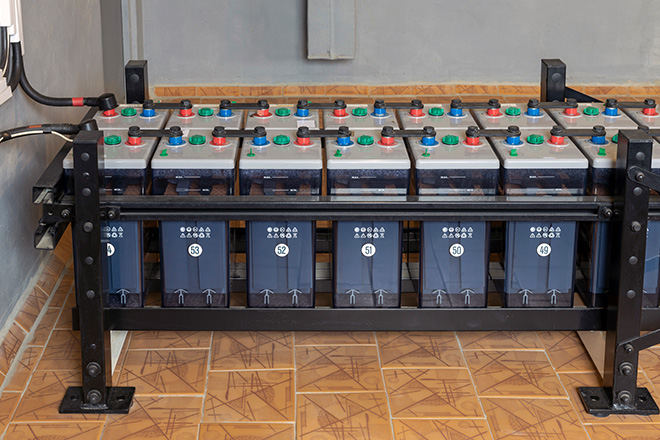Rebates change the math on solar power, battery storage

Customer interest in solar on the rise with new offers
B.C.'s solar generation potential can't quite compete with places like California and Mexico, but that has never stopped this province's true believers. It's just so tempting to take advantage of "free" energy from the sun.
And now, our incentives and rebates for industrial, commercial, and residential solar projects will make it easier to make a case for investment in solar and expand customer buy-in beyond those early adopters. The rebates come just months after the federal government stopped taking applications for the Greener Homes Program, including grants of up to $5,000 for solar generation projects.
"We've had tons of interest from industry and lots of questions from customers – all sorts of stakeholders interested in the new offers," says BC Hydro program manager Margo Longland, adding that a recent webinar on the solar and battery storage offers drew more than 100 Alliance members.
Since the program launched on July 23, rebates became available for up to $5,000 on eligible grid-connected solar panels and up to an additional $5,000 for battery storage systems to qualifying residential customers. Eligible businesses and multi-unit residential buildings can access up to $50,000 in combined solar and battery incentives, while combined rebates of up to $150,000 are available for social housing, Indigenous communities and remote micro-grid communities.
For large commercial and industrial customers, we offer feasibility study funding and custom incentives (for solar, wind, micro hydro, waste heat recovery, and other self-generation based projects) for load displacement.
Factoring into the improved viability of solar generation are falling prices for photovoltaic (PV) panels, as well as existing investment tax credits and capital cost allowance tax deductions from government.
"We're seeing solar PV project costs coming down even in the last six months," says program manager Shantanav Bhowmick. "Based on the quotes in proposals that we've seen from solar PV vendors to customers, costs per kilowatt have declined in these past months."
The basic eligibility requirement for all solar and battery storage rebates is that projects be connected to the BC Hydro grid through our self-generation program (previously called net metering). It allows customers to power their homes or businesses with privately generated renewable energy, with the flexibility to rely on our grid when they need it, and to earn bill credits for any self-generated energy they sent to the grid. And to be eligible for custom incentives, the load displacement projects must have estimated energy displacement through generation of 25,000 kWh per year or more.
Incentives are limited to new projects and/or the expansion of current self-generation projects.
Large customer self-generation incentives aren't only about solar
Bhowmick is quick to point out that large commercial and industrial customers have a variety of incentive options, along with several choices for the type of self-generation project they take on such as solar, wind, micro hydro, or waste heat recovery.
Depending on the simplicity of their load displacement project, customers can proceed directly with incentives. For more complex projects, we strongly recommend first completing a feasibility study, which can include calculations around which generation method is most appropriate.
Who's eligible for the offers? Industrial customers on our large general service distribution rate or transmission rate, and large commercial customers with annual electricity consumption of 2 gigawatt-hours (GWh) or more company-wide. Shantanav says that the large commercial sector includes school districts, municipalities, large universities and colleges, healthcare facilities, and large commercial and retail properties.
Customers work with an Alliance member to decide if they're ready to move forward with a project. Customers with complex projects may also choose to complete a feasibility study to understand the costs and energy benefits of implementing a solar or other load displacement option.
"The feasibility study offer is used for investigating any type of energy management opportunities," says Bhowmick. "It could include low-carbon electrification opportunities, energy efficiency, or demand-response opportunities."
While solar generation is an intermittent form of generation, Bhowmick says it can be particularly well-suited to customers who can use that solar power during regular business hours – such as daytime on weekdays – to help offset usage peaks and demand charges.
So far, most project applications have been for what Bhowmick calls the "simple solar option", the direct-to-incentives strategy that skips the feasibility study option. Most of the projects recently have been for solar energy rather than heat recovery or other renewable options, which while holding more potential for generation than solar, tend to be more costly and less straightforward.
"Solar is probably the easiest technology to design and implement," he says. "Customers may have done a feasibility study on their own, or the project may be so simple that they can get a quote for construction from a solar PV vendor, run the math, calculate the incentive and the estimated energy they can generate."
More customers in B.C. expected to add solar and/or battery storage
In what is the solar capital of the U.S., 30% of single-family homes in Hawaii are equipped with solar panels, while about one in five homes in California has some solar generation. The numbers in B.C. are less than 5%, at about 10,000 homes.
Aside from off-the-grid locations, homes and businesses in B.C. have access to renewable, mainly hydroelectric power that's far more affordable than in regions that have gone big on solar. Large power customers and residents in California generally pay three to four times as much for electricity than in B.C.
But the new solar rebates are expected to boost those B.C. numbers by as much as 3,000 over the next year, and potentially add as many as 5,000 to 10,000 per year down the road.
"I don't think we'll see this market transformation happen overnight, with every rooftop in B.C. having solar panels on it," says Longland. "But we expect it to grow in popularity." Some common reasons why people invest in solar include a desire for greater energy independence, to offset the bills for high electricity use, or to meet particular needs in terms of reliability, such as medical aids that run on electricity where you can't have a power outage.
While a small percentage of British Columbians have added solar power generation, far fewer still have battery storage systems such as Tesla Powerwalls. Longland points out that batteries pair well with solar PV systems and allow customers to use solar power not just when the sun is shining, but also after dark.
"Batteries can maximize the benefits of a solar PV system and provide even more value when used with the new optional time-of-day rate that enables customers to charge at lower rates during off-peak hours," she said.



